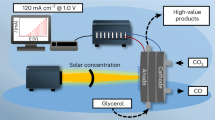Abstract
HYDROGEN peroxide and other hydroperoxides are thought to play a part in forest decline1–7. The toxic effects of these compounds on plants are well documented1–4 and some hydroperoxides, including H2O2, have been detected in forest air5,6 and in plant leaves7. Higher concentrations of H2O2 have been found inside forests compared with those measured close to the forest perimeter8. The reaction of atmospheric ozone with the isoprene and terpenes emitted by vegetation results in the formation of a wide variety of radicals9,10 whose subsequent reactions can contribute to the formation of hydroperoxides. We have used tunable-diode laser absorption spectroscopy to investigate the reaction of ozone with some alkenes, including isoprene and some monoterpenes, to see whether H2O2 is formed under a variety of atmospheric conditions. All the reactions studied produced H2O2 and a significant increase in the yields of H2O2 was observed when water vapour was present. The 'water effect' is the result of a direct reaction of water vapour with the Criegee biradical (the main intermediate in reactions of ozone with alkenes). From our results, we conclude that this reaction could have a more important role in the formation of H2O2 and other hydroperoxides than the self- or cross-reactions of peroxy radicals, thereby contributing to forest decline.
This is a preview of subscription content, access via your institution
Access options
Subscribe to this journal
Receive 51 print issues and online access
$199.00 per year
only $3.90 per issue
Buy this article
- Purchase on Springer Link
- Instant access to full article PDF
Prices may be subject to local taxes which are calculated during checkout
Similar content being viewed by others
References
Masuch, D., Kettrup, P., Mallant, A. & Slanina, J. Verein Deutscher Ingenieure-Berichte 560, 761–776 (1985).
Möller, D. Atmos. Envir. 23, 1625–1627 (1989).
Sies, H. Angew. Chem. 98, 1061–1075 (1986).
Rennenberg, H. in Symp. Verteilung und Wirkung von Photooxidanten im Alpenraum, 360–370. (Gesellschaft für Strahlen und Umweltforschung, Garmisch-Partenkirchen, 1988).
Hellpointer, E. & Gäb, S. Nature 337, 631–634 (1989).
Kok, G. L. & McLaren, S. E. Proc. Int. Conf. Generation of Oxidants on Regional and Global Scale abstr. 6–3 (University of East Anglia, 1989).
Hewitt, N. C., Kok, G. L. & Fall, R. Nature 344, 56–58 (1990).
Jacob, P. & Klockow, D. Proc. 3rd French-German Workshop on Tropospheric Chemistry by Laboratory Studies (eds Becker, K. H. & Carlier, P.) 77–79 (Universitact Wuppertal, 1987).
Atkinson, R. & Lloyd, A. C. J. phys. Chem. Ref. Data 13, 369–444 (1984).
Martinez, R. I., Herron, J. T. & Huie, R. E. J. Am. chem. Soc. 103, 3807–3820 (1981).
Bechara, J., Becker, K. H. & Brockmann, K. J. Proc. 5th European Symp. Physico-Chemical Behaviour of Atmospheric Pollutants (Restelli, G. & Angeletti, G.) 27–31 (Kluwer, Dordrecht, 1990).
Becker, K. H., Brockmann, K. J. & Bechara, J. Geophys. Res. Lett. 16, 1367–1370 (1990).
Graedel, T. E. Rev. Geophys. & Space Phys. 17, 937–947 (1979).
Yokouchi, Y. & Ambe, Y. Atmos. Envir. 19, 1271–1276 (1985).
Bailey, P. S. Chem. Rev. 58, 925–1010 (1958).
Hamilton, E. J. & Lii, R. Int. J. chem. Kinet. 9, 875–885 (1977).
Hatakeyama, S., Bandow, H., Okuda, M. & Akimoto, H. J. phys. Chem. 85, 2249–2254 (1981).
Niki, H., Maker, P. D., Savage, C. M. & Breitenbach, L. P. J. phys. Chem. 86, 1858–1861 (1982).
Wadt, W. R. & Goddard, W. A. J. Am. chem. Soc. 97, 3004–3021 (1975).
Yamamoto, Y., Niki, E., Shiokawa, H. & Kamiya, Y. J. org. Chem. 44, 2137–2142 (1979).
Gäb, S., Hellpointer, E., Turner, W. V. & Korte, F. Nature 316, 535–536 (1985).
Herron, J. T., Martinez, R. I. & Huie, R. E. Int. J. chem. Kinet 14, 201–224 (1982).
Suto, M., Manzanares, E. R. & Lee, L. C. Envir. Sci. Technol. 19, 815–820 (1985).
Chameides, W. L. Envir. Sci. Technol. 23, 595–600 (1989).
Author information
Authors and Affiliations
Rights and permissions
About this article
Cite this article
Becker, K., Brockmann, K. & Bechara, J. Production of hydrogen peroxide in forest air by reaction of ozone with terpenes. Nature 346, 256–258 (1990). https://doi.org/10.1038/346256a0
Received:
Accepted:
Issue Date:
DOI: https://doi.org/10.1038/346256a0
This article is cited by
-
Halogenation processes linked to red wood ant nests (Formica spp.) and tectonics
Journal of Atmospheric Chemistry (2017)
-
Observation of hydrogen peroxide concentrations in a Japanese red pine forest
Journal of Atmospheric Chemistry (2008)
-
Organic peroxide production in the Cl2-ethane-air photoreaction system
Science in China Series B: Chemistry (2001)
Comments
By submitting a comment you agree to abide by our Terms and Community Guidelines. If you find something abusive or that does not comply with our terms or guidelines please flag it as inappropriate.



